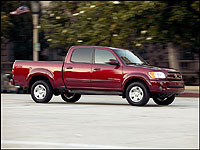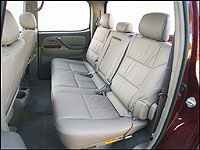Available in both rear-drive 4X2 and 4X4 configurations, the Tundra Double Cab rides on a stout ladder frame chassis that is longer than the chassis shared by the two-door Tundra Standard Cab and the four-door Tundra Access Cab.
 |
| The 4.7-litre V8 produces 240 horsepower and 315 lb-ft of torque. If you wait for a 2005, the power goes up to 282 horsepower and 325 lb-ft of torque. (Photo: Toyota Canada) |
The 4X2 Double Cab, 4X4 Double Cab and 4X4 Double Cab Limited are powered by a V8 engine designed with stump-pulling in mind. The 4.7-litre powerplant produces 240 horsepower and an authoritative 315 lb-ft of torque. That horsepower rating seems a little anemic given the cabin and box capacities of the Tundra, but the big torque number helps in that department.
Next year's Tundra will arrive stock with a 4.0-liter V6 making 245 horsepower and 283 lb-ft of torque, not bad for a 6-cylinder. The V8 gets upgraded as well, with a much bolder 282 horsepower and 325 lb-ft of torque.
 |
| Cabin comfort was top priority when Toyota engineers set out to make the biggest Tundra ever. (Photo: Toyota Canada) |
While my test Tundra, and all 2004 Tundras feature a four-speed automatic transmission featuring a lock-up torque converter and overdrive cancel switch, next-year's truck will get a 5-speed auto in both V6 and V8 guises.
My tester, the Double Cab 4X4, was also equipped with Toyota's Automatic Disconnecting Differential (ADD) for all the benefits of convenient, shift-on-the-fly, part-time 4WD.
The ride and handling of all Tundras is solid and sure, though the fully independent, double-wishbone front suspension and solid axle rear suspension don't smooth out all the bumps.

